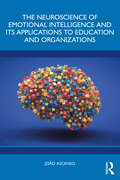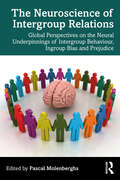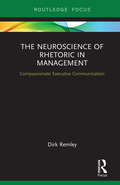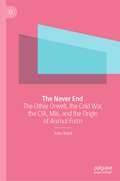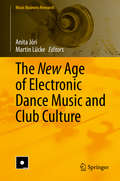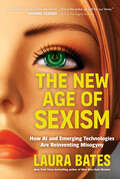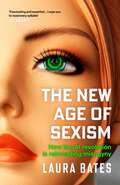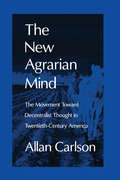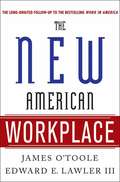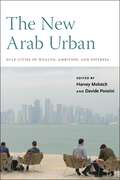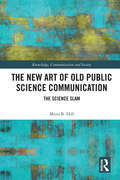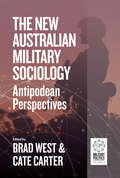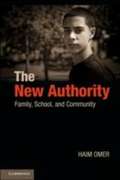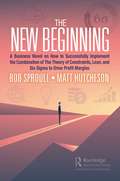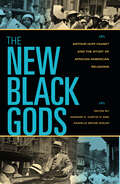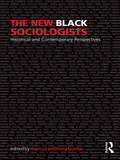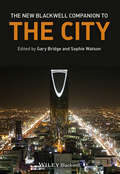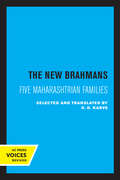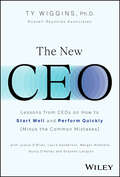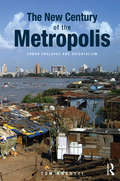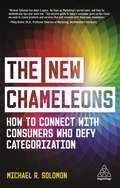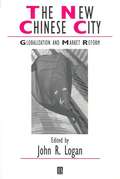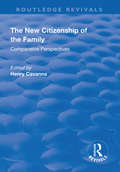- Table View
- List View
The Neuroscience of Emotional Intelligence and Its Applications to Education and Organizations
by João AscensoThis book provides a clear understanding of the neuromechanisms of emotional intelligence and its applications to education and organizations through practical exercises.Divided into three parts, the book begins by explaining the data that help us understand the neural mechanisms of emotional intelligence. Part 2 focuses on application in educational contexts by presenting emotional intelligence education programs for children and adolescents as well as an analysis of emotional intelligence from a practical point of view. Part 3 switches the focus to organizations through the leadership with emotional and social intelligence model as proposed and validated by Daniel Goleman and Richard Boyatzis. Both parts offer a series of practical and engaging exercises for application to adolescents, children and educators, and organizational environments respectively. Presented simply, the book gives a scientifically rigorous and structured overview of how neuroscience has helped in understanding the neural mechanisms of emotions and its applications.It is indispensable reading for neuroscientists, psychologists, leaders, managers, teachers, and educators, and all those interested in the search for personal and professional success.
The Neuroscience of Intergroup Relations: Global Perspectives on the Neural Underpinnings of Intergroup Behaviour, Ingroup Bias and Prejudice
by Pascal MolenberghsThis path-breaking book is the first collection to provide a scientific global overview on the social neuroscience of intergroup relations, and the neural mechanisms that drive processes such as prejudice, racism and dehumanisation. Although intergroup behaviour has long been an important topic in psychology, attention to the underlying neural processes that influence it has often been neglected. If we truly want to understand the driving forces of social behaviours such as racism, bias and violence between groups, it is essential that we better understand the neuroscience behind these processes. Providing critical insights on these underpinnings, topics covered in the book include the neuroscience of ingroup bias, empathy, dehumanisation, competition, ideological bias and prejudice between groups. As well as explaining how genes and environment interact to create attitudes between groups and how this can lead to different cultures, later chapters also give practical solutions on how to reduce ingroup bias and support prosocial behaviour between groups through better neuroscientific understanding. Featuring contributions from world-leading experts, this is fascinating reading for students and researchers in social psychology and neuroscience, and is ideal for anyone examining intergroup relations from a social neuroscientific perspective, or using social neuroscience methods for the first time.
The Neuroscience of Rhetoric in Management: Compassionate Executive Communication (Routledge Focus on Business and Management)
by Dirk RemleyExecutives continue to lose their position because of inability to communicate organizational decisions to employees and boards effectively. More than just the words one writes or speaks, communication includes one’s actions and other non-verbal attributes that carry meaning for audiences. Further, decisions may affect these audiences differently emotionally and economically, complicating communication with each group. This book provides case studies to illustrate communication failure that directly resulted in executives' termination. These case studies include the fields of higher education, health care administration, computer technology, medical research, news media, and advertising. Synthesizing scholarship in neuroscience about how the brain processes information from verbal, visual and other stimuli as well as management and communication principles found in books valued in leadership development programs, this book explains why audiences reacted negatively to messages and describes how the messages could have been delivered to get a better response. The book includes rubrics to assist readers develop their own messages. Executives and those in leadership development programs will benefit from this book.
The Never End: The Other Orwell, the Cold War, the CIA, MI6, and the Origin of Animal Farm
by John ReedThis book presents full history of the origin of Orwell’s Animal Farm, as well as a translation of the Russuian/Ukranian source work. Has George Orwell lost his saintly luster? In The Never End, rabble-rouser, dogged investigator, and consummate literary stylist John Reed collects two decades of subject-Orwell findings previously published in Pank, Guernica, Literary Hub, The Brooklyn Rail, The Rumpus, The New York Press, The Believer, Harper’s Magazine and The Paris Review. Reed’s treatment of Orwell is corrective and peerlessly contemporary; he views Orwell in a twenty-first century global context, considering Orwell’s collaboration with Cold War intelligence operations—US and UK—with unfaltering objectivity. It’s hard to imagine that Orwell—in our own moment of global doublethink—wouldn’t have wanted his devotion to contrariety applied to the literary legacy he left behind. The Never End is at once a hatchet job and a celebration. Animal Farm, based on a previously unknown Russian short story? Animal Farm, deployed by the CIA, MI6 and the Congress for Cultural Freedom? Orwell, turning over blacklists in a McCarthy-esque act of betrayal? The Cold War? Does it last forever? Russia, the “Axis of Evil,” and now China? But. Orwell. Course syllabi. Literary laurels. Snitch. Why do we keep coming back? For the wrong reasons? Or because we know Old Benjamin would want us to know the truth?
The New African Diaspora in Vancouver
by Gillian CreeseThe New African Diaspora in Vancouver documents the experiences of immigrants from countries in sub-Saharan Africa on Canada's west coast. Despite their individual national origins, many adopt new identities as 'African' and are actively engaged in creating a new, place-based 'African community.' In this study, Gillian Creese analyzes interviews with sixty-one women and men from twenty-one African countries to document the gendered and racialized processes of community-building that occur in the contexts of marginalization and exclusion as they exist in Vancouver.Creese reveals that the routine discounting of previous education by potential employers, the demeaning of African accents and bodies by society at large, cultural pressures to reshape gender relations and parenting practices, and the absence of extended families often contribute to downward mobility for immigrants. The New African Diaspora in Vancouver maps out how African immigrants negotiate these multiple dimensions of local exclusion while at the same time creating new spaces of belonging and emerging collective identity.
The New Age of Electronic Dance Music and Club Culture (Music Business Research)
by Martin Lücke Anita JóriThis book offers a comprehensive overview of electronic dance music (EDM) and club culture. To do so, it interlinks a broad range of disciplines, revealing their (at times vastly) differing standpoints on the same subject. Scholars from such diverse fields as cultural studies, economics, linguistics, media studies, musicology, philosophy, and sociology share their perspectives. In addition, the book features articles by practitioners who have been active on the EDM scene for many years and discuss issues like gender and diversity problems in general, and the effects of gentrification on club culture in Berlin. Although the book’s main focus is on Berlin, one of the key centers of EDM and club culture, its findings can also be applied to other hotspots. Though primarily intended for researchers and students, the book will benefit all readers interested in obtaining an interdisciplinary overview of research on electronic dance music.
The New Age of Sexism: How AI and Emerging Technologies Are Reinventing Misogyny
by Laura BatesMisogyny is being hardwired into our future. Can we stop it?We like to believe we're moving closer to equality, riding the wave of technological progress into a brighter, fairer future. But beneath the glossy surface of innovation lies a chilling truth: new technologies are not just failing to solve age-old inequalities—they're deepening them.In The New Age of Sexism, acclaimed author and activist Laura Bates exposes how misogyny is being coded into the very fabric of our future. From the biases embedded in artificial intelligence to the alarming rise of sex robots and the toxic dynamics of the metaverse, Bates takes readers on a shocking journey into a world where technology is weaponized against women.This isn't a dystopian warning about what might happen. It's a harrowing account of what's happening now and the dangers we face if we don't act. With clarity and urgency, Bates reveals how these advancements are dragging society backward, reinforcing harmful stereotypes, and jeopardizing decades of progress in the fight for gender equality.Eye-opening and empowering, The New Age of Sexism is a rallying cry for awareness and action in a world where the battle for equality has entered a dangerous new frontier.
The New Age of Sexism: How the AI Revolution is Reinventing Misogyny
by Laura Bates&‘Laura Bates explains how they built the future – and forgot to put women in it&’ CAITLIN MORAN 'Fascinating and essential... I urge you to read every syllable' JO BRAND &‘All men must read this book if they have any interest in a truly just, fair and equal society&’ ROBIN INCEAI is here, bringing a seismic shift in the way our society operates. Might this mean a future reimagined on equitable terms for women and marginalised groups everywhere?Not unless we fight for it. At present, power remains largely in the hands of a few rich, white men. New AI-driven technologies, with misogyny baked into their design, are putting women in danger, their rights and safety sacrificed at the altar of profitability and reckless speed. In The New Age of Sexism, Sunday Times bestselling author and campaigner Laura Bates takes us deep into the heart of this rapidly evolving world. She explores the metaverse, confronts deepfake pornography, travels to cyber brothels, tests chatbots, and hears from schools in the grip of online sexual abuse, showing how our lives – from education to work, sex to entertainment – are being infiltrated by easily accessible technologies that are changing the way we live and love. What she finds is a wild west where existing forms of discrimination, inequality and harassment are being coded into the future we will all have little choice about living in – unless we seize this moment to demand change. Gripping, courageous and eye-opening, The New Age of Sexism exposes a phenomenon we can&’t afford to ignore any longer. Our future is on the line. We need to act now, before it is too late. &‘Urgent reading for anyone who is interested in the intersection of tech and gender equality, and indeed anyone who wants to be a part of building a better future, free from misogyny&’ EMMA-LOUISE BOYNTON &‘A brilliantly researched, incredibly illuminating and frequently chilling account of the next chapter in tech's ongoing assault on our core values. A chapter that is already unfolding around us all&’ JAMES O&’BRIEN
The New Agrarian Mind: The Movement Toward Decentralist Thought in Twentieth-Century America
by Allan C. CarlsonThe self-sufficiency and regional outlook of farm life characterized the United States until the Civil War period. With the triumph of the industrial North over the rural South, the expansion of urbanism, and the closing of the frontier, the agrarian sector became an economic and cultural minority. The social benefits of rural life - a sense of independence, commitment to democracy, an abundance of children, stable community life - were threatened. This volume examines the rise of a distinctive agrarian intellectual movement to combat these trends. The New Agrarian Mind, now in paperback, synthesizes the thought of twentieth-century agrarian writers. It weaves together discussions of major representative figures, such as Liberty Hyde Bailey, Carle Zimmerman, and Wendell Berry, with myth-shattering analyses of the movement's cultural diversity, intellectual influence, and ideological complexity. Collectively labeled the New Agrarians to distinguish them from the simpler Jeffersonianism of the nineteenth century, they shared a coherent set of goals that were at once socially conservative and economically radical.
The New American Workplace
by Susan R. Meisinger James O'Toole Edward E. LawlerThirty years ago, the bestselling "letter to the government" Work in America published to national acclaim, including front-page coverage in The New York Times, Wall Street Journal, and Washington Post. It sounded an alarm about worker dissatisfaction and the effects on the nation as a whole. Now, based on thirty years of research, this new book sheds light on what has changed - and what hasn't. This groundbreaking work will illuminate the new critical issues - from worker demands to the new ethical rules to the revolution in culture at work.
The New Arab Urban: Gulf Cities of Wealth, Ambition, and Distress
by Harvey Molotch and Davide PonziniCities of the Arabian Peninsula reveal contradictions of contemporary urbanizationThe fast-growing cities of the Persian Gulf are, whatever else they may be, indisputably sensational. The world’s tallest building is in Dubai; the 2022 World Cup in soccer will be played in fantastic Qatar facilities; Saudi Arabia is building five new cities from scratch; the Louvre, the Guggenheim and the Sorbonne, as well as many American and European universities, all have handsome outposts and campuses in the region. Such initiatives bespeak strategies to diversify economies and pursue grand ambitions across the Earth.Shining special light on Dubai, Abu Dhabi, and Doha—where the dynamics of extreme urbanization are so strongly evident—the authors of The New Arab Urban trace what happens when money is plentiful, regulation weak, and labor conditions severe. Just how do authorities in such settings reconcile goals of oft-claimed civic betterment with hyper-segregation and radical inequality? How do they align cosmopolitan sensibilities with authoritarian rule? How do these elite custodians arrange tactical alliances to protect particular forms of social stratification and political control? What sense can be made of their massive investment for environmental breakthrough in the midst of world-class ecological mayhem?To address such questions, this book’s contributors place the new Arab urban in wider contexts of trade, technology, and design. Drawn from across disciplines and diverse home countries, they investigate how these cities import projects, plans and structures from the outside, but also how, increasingly, Gulf-originated initiatives disseminate to cities far afield.Brought together by noted scholars, sociologist Harvey Molotch and urban analyst Davide Ponzini, this timely volume adds to our understanding of the modern Arab metropolis—as well as of cities more generally. Gulf cities display development patterns that, however unanticipated in the standard paradigms of urban scholarship, now impact the world.
The New Art of Old Public Science Communication: The Science Slam (Knowledge, Communication and Society)
by Miira B. HillThis book investigates the phenomenon of science communication events, as spectacles for legitimizing and communicating science to the public. With attention to events such as ‘Science Slam’, where scientists are asked to present their knowledge in new ways and speak to an audience of laymen, the author examines the participants’ use of stylistic devices borrowed from other events in order to address a diverse audience in a competitive environment. With attention to the performative appearance of scientists on stage and the manner in which contemporary public performing scientists present, problematise and communicate knowledge, the author considers the justifications offered by participants in terms of legitimacy and expectations. Illustrating the crucial role of bodies, techniques, visuals and objects in the communicative construction of (scientific) reality, The New Art of Old Public Science Communication: The Science Slam sheds new light on the construction of improved science communication. As such, it will appeal to social scientists with interests in science communication, the sociology of science and technology, and the sociology of knowledge.
The New Australian Military Sociology: Antipodean perspectives (Military Politics #2)
by Brad West Cate CarterCivil-military relations have changed over time with respect to changing demographics, new domestic and international responsibilities, Industry-Defence cooperation, women in the armed forces and contemporary veteran wellbeing.The New Australian Military Sociology aims to provide an antipodean view to theorising civil-military entanglements and uses Australia’s unique geographic, political and cultural context to serve as a case study for other countries.
The New Authority
by Haim Omer Michal Herbsman Shoshana London SappirHaim Omer builds on his previous work to present a new model of authority for parents, teachers and community workers that is suitable for today's free and pluralistic societies. This new authority contrasts with traditional authority in that it emphasizes self-control and persistence over control of the child, a network of support over a strict hierarchy, taking mutual responsibility for escalations over holding the child solely responsible, patience over threats, non-violent resistance over physical force, and transparency over secrecy. In addition to a thorough discussion of the underlying theory, The New Authority presents a practical program for families, schools and communities. Dr Omer provides specific instructions to combat violence and risky behavior at home and in school, increase parent and teacher interest and support, and implement interventions that increase safety, improve atmosphere and generate community cohesiveness.
The New Authority
by Haim Omer Michal Herbsman Shoshana London SappirHaim Omer builds on his previous work to present a new model of authority for parents, teachers and community workers that is suitable for today's free and pluralistic societies. This new authority contrasts with traditional authority in that it emphasizes self-control and persistence over control of the child, a network of support over a strict hierarchy, taking mutual responsibility for escalations over holding the child solely responsible, patience over threats, non-violent resistance over physical force, and transparency over secrecy. In addition to a thorough discussion of the underlying theory, The New Authority presents a practical program for families, schools and communities. Dr Omer provides specific instructions to combat violence and risky behavior at home and in school, increase parent and teacher interest and support, and implement interventions that increase safety, improve atmosphere and generate community cohesiveness.
The New Beginning: A Business Novel on How to Successfully Implement the Combination of The Theory of Constraints, Lean, and Six Sigma to Drive Profit Margins
by Bob Sproull Matt HutchesonThis book is a sequel to the business novel, The Secret to Maximizing Profitability – A Business Novel on How to Successfully Combine the Theory of Constraints, Lean, and Six Sigma to Drive Profit Margins to New Levels. In The New Beginning, Tom Mahanan, Tires for All’s former Director of Finance, who learned how to combine the Theory of Constraints with Lean and Six Sigma, and then applied it to Tires for All, to take his company to levels of profitability they had never experienced before. As a reward for his work, Tom was given a permanent seat on the Board of Directors, as long as he continued his improvement work at the remaining portfolio of companies owned by the Board of Directors. Tom performed extremely well, but one day he receives a life-changing phone call from his former mentor, Bob Nelson, the man who he had worked with at Tires for All to make amazing improvements. Bob asks him to play golf with him and two others, Jeff Johnson, from Toner International, and Pete Hallwell, the CFO at Maximo Health Center Complex. Pete and Tom share a golf cart during the round and begin chatting about the work Tom had done at Tires for All and the other portfolio of companies. Pete, who works for a healthcare complex of hospitals, is so impressed with the results Tom had achieved, that he invites him to lunch the following week. Tom accepts his offer of lunch and ultimately, Tom signs a consulting agreement with Pete. Tom had provided an example from a previous improvement effort where he worked with a hospital in Chicago to improve their Emergency Department time for STEMI-type heart attack patients. In his explanation, Tom presents a variety of improvement tools which includes the integration of the Theory of Constraints, Lean, and Six Sigma. Tom then meets with his current employer and specifically, the Chairman of the Board of Directors, Jonathan Briggs, to let him know that he will be resigning to form his own consulting firm. Jonathan then surprises Tom by offering him a consulting agreement to improve all of their portfolio companies. The remainder of the book is all about teaching companies how to combine the Theory of Constraints, Lean, and Six Sigma to obtain optimal results. In the final two chapters, a new problem surfaces, which is the Corona Virus. Essentially, this book teaches the reader how to successfully combine and implement the Theory of Constraints, Lean, and Six Sigma to produce results that many companies only dream of having. It covers a variety of different company types including manufacturing and healthcare.
The New Black Gods: Arthur Huff Fauset and the Study of African American Religions
by Edward E. Curtis IV and Danielle Brune SiglerTaking the influential work of Arthur Huff Fauset as a starting point to break down the false dichotomy that exists between mainstream and marginal, a new generation of scholars offers fresh ideas for understanding the religious expressions of African Americans in the United States. Fauset's 1944 classic, Black Gods of the Metropolis, launched original methods and theories for thinking about African American religions as modern, cosmopolitan, and democratic. The essays in this collection show the diversity of African American religion in the wake of the Great Migration and consider the full field of African American religion from Pentecostalism to Black Judaism, Black Islam, and Father Divine's Peace Mission Movement. As a whole, they create a dynamic, humanistic, and thoroughly interdisciplinary understanding of African American religious history and life. This book is essential reading for anyone who studies the African American experience.
The New Black Sociologists: Historical and Contemporary Perspectives (Sociology Re-Wired)
by Marcus A. HunterThe New Black Sociologists follows in the footsteps of 1974’s pioneering text Black Sociologists: Historical and Contemporary Perspectives, by tracing the organization of its forbearer in key thematic ways. This new collection of essays revisit the legacies of significant Black scholars including James E. Blackwell, William Julius Wilson, Joyce Ladner, and Mary Pattillo, but also extends coverage to include overlooked figures like Audre Lorde, Ida B. Wells, James Baldwin and August Wilson - whose lives and work have inspired new generations of Black sociologists on contemporary issues of racial segregation, feminism, religiosity, class, inequality and urban studies.
The New Blackwell Companion to the City
by Sophie Watson Gary BridgeThis book considers the state of the city and contemporary urbanisation from a range of intellectual and international perspectives. The most interdisciplinary collection of its kindProvides a contemporary update on urban thinking that builds on well established debates in the fieldUses the city to explore economic, social, cultural, environmental and political issues more broadlyIncludes contributions from non Western perspectives and cities
The New Brahmans: Five Maharashtrian Families
by D.D. KarveThis title is part of UC Press's Voices Revived program, which commemorates University of California Press’s mission to seek out and cultivate the brightest minds and give them voice, reach, and impact. Drawing on a backlist dating to 1893, Voices Revived makes high-quality, peer-reviewed scholarship accessible once again using print-on-demand technology. This title was originally published in 1963.
The New CEO: Lessons from CEOs on How to Start Well and Perform Quickly (Minus the Common Mistakes)
by Ty WigginsYour personal guide to navigating the first days, weeks, and months in the top job, based on powerful interviews with today's most successful CEOs. Becoming a CEO is a high-stakes moment, whether it's your first, second, or third time in the seat. What you say and how you act in your early days as CEO sets the tone for how you'll be perceived for years to come. Yet, until now, few CEOs have shared their stories on what worked, what didn't, and what they wish they'd done differently. In The New CEO, Dr. Ty Wiggins, an experienced leadership advisor specializing in CEO transitions, explains how to land well as a new CEO, accelerate your impact, and unlock the most affirming experience of your career. Drawing on compelling storytelling and groundbreaking research of hundreds of CEOs around the world, the book offers a incisive guide on what to say and do as a new CEO, including how to define your priorities, build your team, fast-track critical changes, work with the board, and set (or reset) the organization's culture. You'll also find: Why being a CEO is the toughest (and loneliest) job in business—and what to do about it. How to overcome the “First 100 Days” mindset and pressure for early wins to deliver sustainable, long-term success. How to avoid getting trapped in the “CEO Bubble,” as well as how to navigate (inevitable) challenges, knocks, and missteps. Perfect for newly appointed CEOs—whether it's your first time on the job or your second or third—The New CEO is also an essential resource for anyone seeking insights into the mindset and priorities of CEOs, including board members and directors, in-house counsel, leadership coaches, other executives, and consultants.
The New Century of the Metropolis: Urban Enclaves and Orientalism
by Tom AngottiThe problems created by metropolitanization have become increasingly apparent. Attempts to limit growth, disperse populations and plan neighbourhoods have been largely unsuccessful. Strategies are needed to improve the world's major cities in the twenty-first century. Tom Angotti is fundamentally optimistic about the future of the metropolis, but questions urban planning’s inability to integrate urban and rural systems, its contribution to the growth of inequality, and increasing enclave development throughout the world. Using the concept of 'urban orientalism' as a theoretical underpinning of modern urban planning grounded in global inequalities, Angotti confronts this traditional model with new, progressive approaches to community and metropolis. Written in clear, precise terms by an award-winning author, The New Century of the Metropolis argues that only when the city is understood as a necessary and beneficial acccompaniment to social progress can a progressive, humane approach to urban planning be developed.
The New Chameleons: How to Connect with Consumers Who Defy Categorization
by Michael R. SolomonConsumers are changing but the marketing categories used to identify them have not. Engage with this new generation of consumers who increasingly take for granted that products and advertising will blend their multiple brand identities rather than market to them as a specific subculture. Male or female, work or play, online or offline. These and other market categories are no longer relevant as modern consumers defy traditional boundaries and identify as members of multiple subcultures. The New Chameleons reveals how to engage with this new generation and how to stand out among the competition. Global consumer behavior expert Michael R. Solomon directs marketers to move beyond their traditional categories and communicate with consumers as individuals rather than as a market segment. He explains how traditional marketing is based on the assumption of boundaries between us and them, the individual and the collective, producer and consumer, work and play, humans vs. computers, and editorial vs. commercial. He then shows how those boundaries are blurring: people identify with members of multiple subcultures; individuals seek collective advice before making a purchase; consumers no longer distinguish between purchases online or in-store; consumer-generated content becomes the norm; gender identity is fluid; gamification strategies turn work into play; and identity marketing becomes more popular. Combining history, data, experience and examples, The New Chameleons is written for every marketer (or reader) who wants to offer products and services that resonate with consumers now and in the future.
The New Chinese City: Globalization and Market Reform (IJURR Studies in Urban and Social Change Book Series #52)
by John R. LoganUrbanisation and urban development issues are the focus of this comprehensive account which introduces readers to the far-reaching changes now taking place in Chinese cities.
The New Citizenship of the Family: Comparative Perspectives
by Henry CavannaThis title was first published in 2000: This volume offers international comparative perspectives and critical analyses of the interconnections between family behaviour and its political regulation, the new economics of the family and the role of the family in building citizenship.
